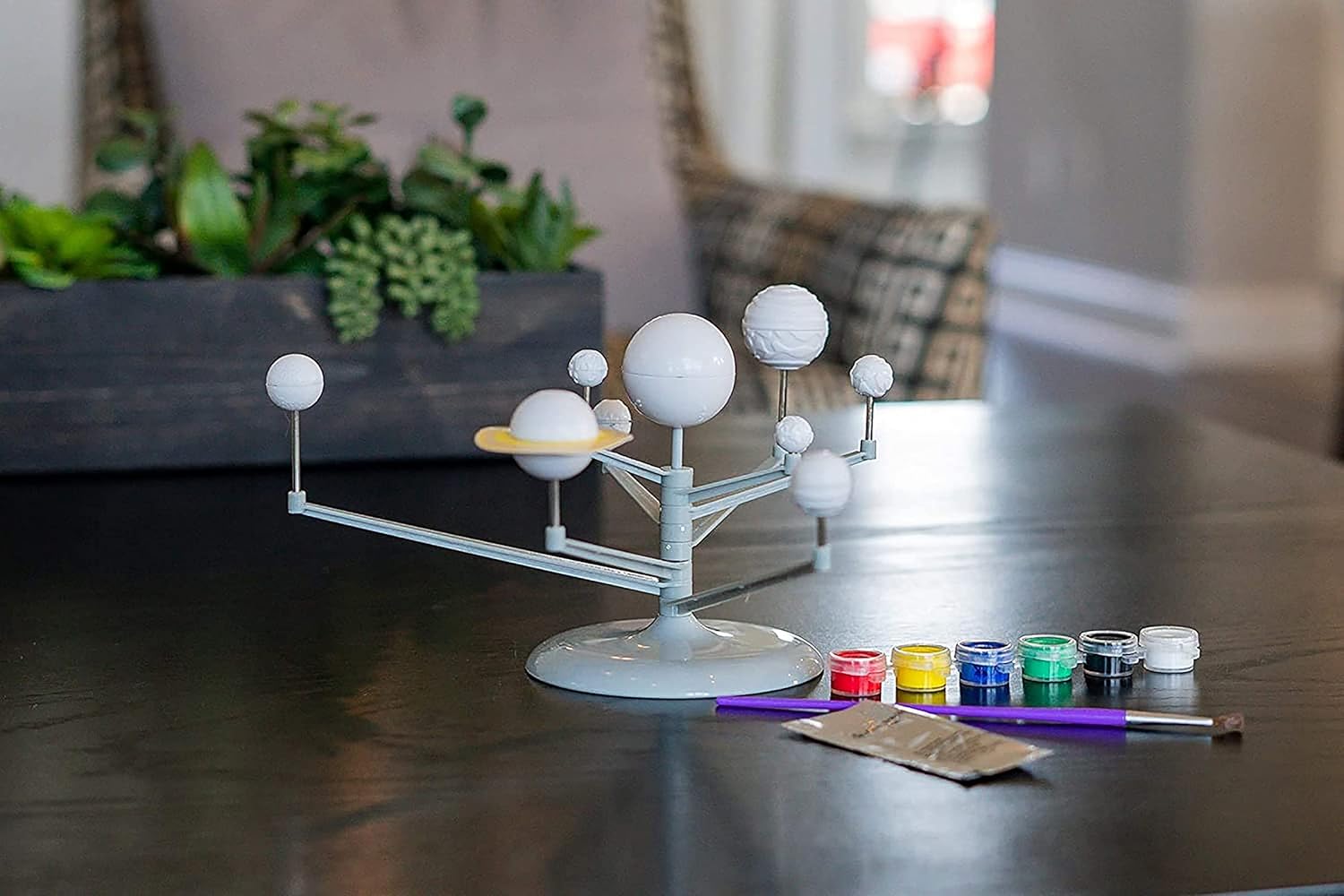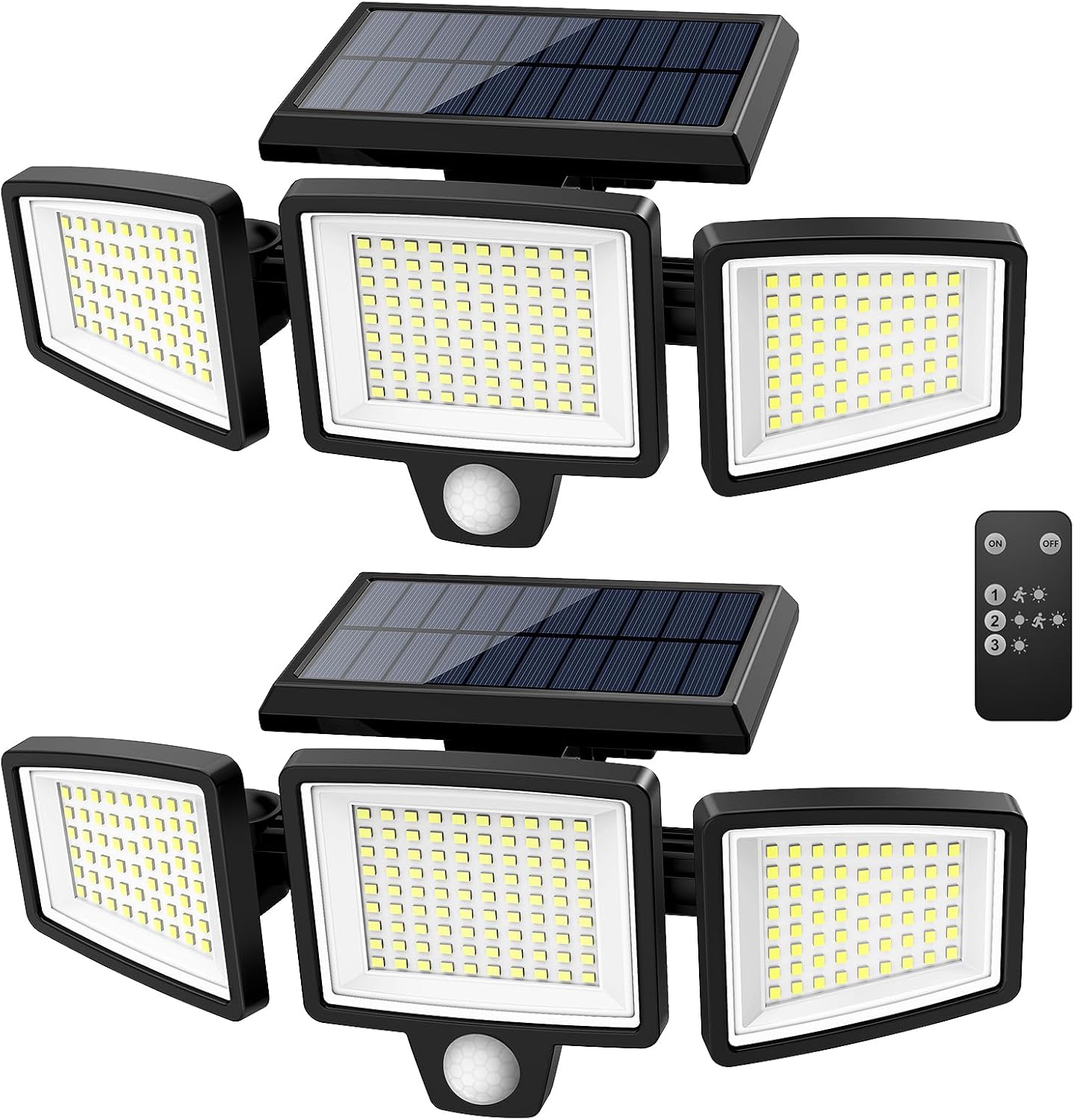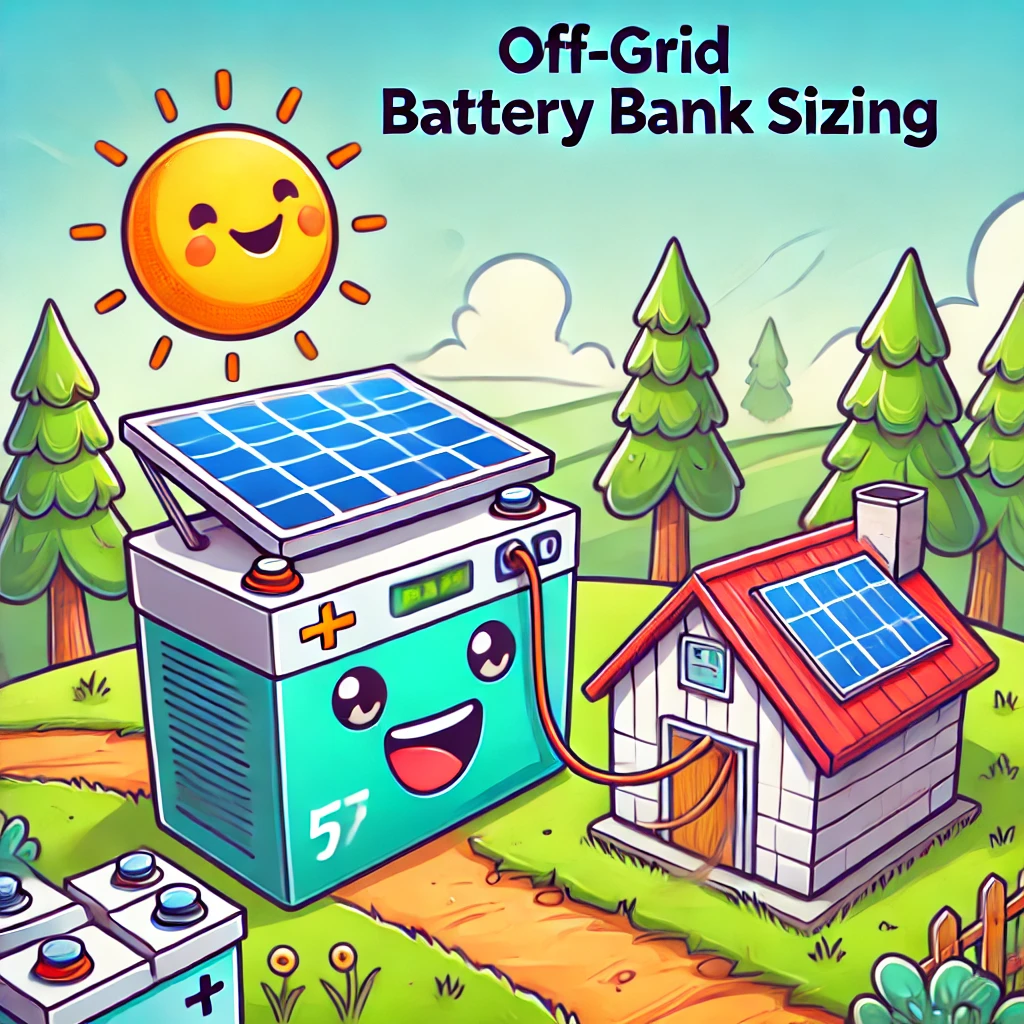Igniting Young Minds: Why Astronomy Education Starts at Home
Picture this: your child’s bedroom transforms into a glowing galaxy as night falls. Eight planets suspended overhead emit a soft, mysterious glow, sparking wonder and countless questions about our place in the universe. This isn’t science fiction—it’s the magic created by the 4M Solar System Planetarium, a hands-on learning adventure that’s revolutionizing how kids connect with space science.
In today’s digital world, finding educational activities that genuinely captivate young minds while keeping screens at bay feels like searching for life on Mars. The 4M Solar System Planetarium (Model: 3427) bridges this gap beautifully, offering an immersive journey through our cosmic neighbourhood that children can build with their own hands.
This deep-dive exploration reveals everything parents, educators, and gift-seekers need to know about this remarkable STEM kit. We’ll uncover why it’s become a bestseller, how it transforms abstract space concepts into tangible understanding, and whether it deserves a spot in your home or classroom.
Unpacking the Cosmic Adventure: What Makes This Kit Special?
Beyond Ordinary Toys: A True Learning Experience
The 4M Solar System Planetarium isn’t just another toy destined for the closet after a week. It’s a comprehensive educational platform disguised as an engaging craft project. Designed for curious minds aged 8 and beyond, this kit masterfully blends artistic creativity with scientific accuracy.
What sets this planetarium apart is its multifaceted approach to learning. Children don’t simply read about planets—they construct them, paint them, arrange them in proper order, and then live with their creation as a daily reminder of cosmic wonders. This multisensory engagement creates neural pathways that textbook learning alone cannot achieve.
The Complete Package: Inside Your Cosmic Toolkit
When you open the 4M Solar System Planetarium box, you’ll discover a carefully curated collection of components:
Eight Planetary Models: Each representing our solar system’s major planets from tiny Mercury to distant Neptune. You might notice Pluto’s absence—an excellent conversation starter about evolving scientific understanding and how astronomers reclassified it as a dwarf planet in 2006.
Luminescent Paint Pen: This isn’t ordinary paint. The squeeze applicator contains special glow-in-the-dark formula that absorbs ambient light and releases a gentle luminescence when darkness falls. It’s this feature that transforms bedtime from routine to astronomical wonder.
Precision Stencils: Even artistically hesitant children can achieve impressive results using these templates. They guide young artists in adding authentic planetary features—Saturn’s magnificent rings, Jupiter’s swirling Great Red Spot, or Earth’s familiar continents.
Structural Elements: Rods and string provide flexibility in how you display your creation. Whether as a rotating mobile, a linear arrangement, or a custom configuration, the mounting system adapts to your space.
Knowledge Resources: A vibrant wall chart packed with planetary facts becomes a long-term reference tool. Ten quiz sets turn casual glances at the display into active learning moments, reinforcing knowledge through repeated engagement.
Clear Instructions: Step-by-step guidance ensures success, though the process challenges children appropriately for their developmental stage, building problem-solving skills alongside astronomical knowledge.
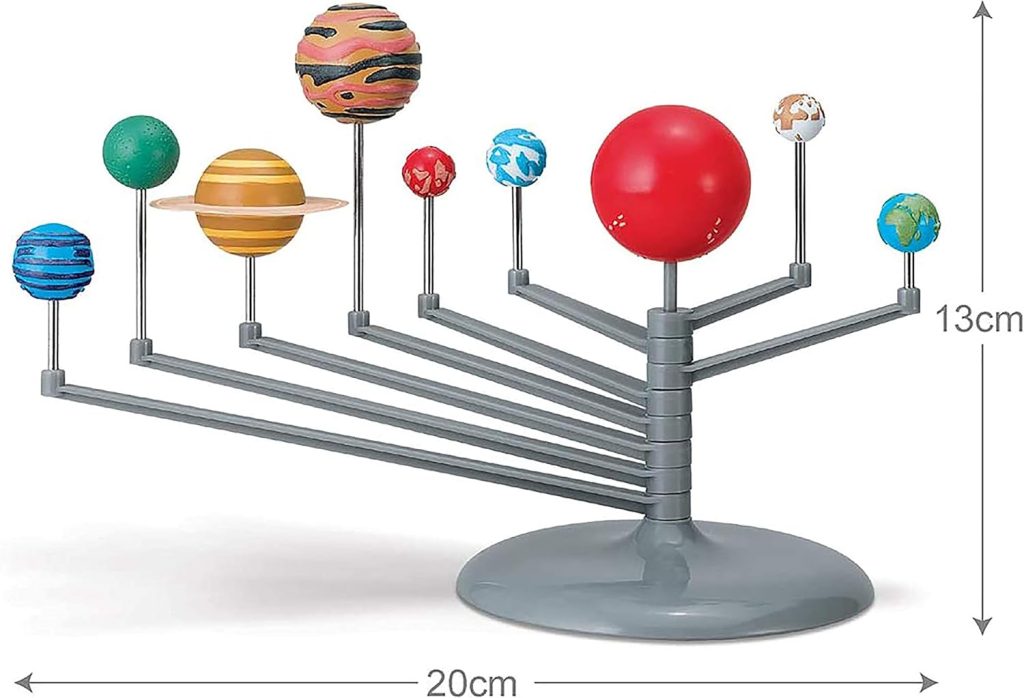
The Battery-Free Advantage: Sustainability Meets Learning
Here’s something refreshing in our battery-dependent world: this entire experience requires zero batteries. No monthly replacements, no corroded compartments, no electronic waste. The 4M Solar System Planetarium operates on pure human creativity and ambient light for the glow effect.
This design choice carries deeper lessons beyond convenience. It opens conversations about environmental responsibility, renewable versus non-renewable resources, and how we can make mindful choices about the products we bring into our homes.
Educational Gold: How This Kit Develops Young Minds
STEM Integration That Actually Works
Educational buzzwords flood the toy market, but the 4M Solar System Planetarium delivers authentic STEM learning:
Scientific Thinking: Children absorb genuine astronomical facts—planetary composition, atmospheric conditions, orbital mechanics, and relative distances. The physical model makes abstract concepts concrete. Understanding why gas giants dwarf rocky planets becomes intuitive when you’re holding both in your hands.
Technological Understanding: Scale modeling introduces technological concepts. How do we represent something impossibly large in manageable size? This question underlies everything from architectural models to data visualization.
Engineering Principles: Assembly demands spatial reasoning. Which rod connects where? How does balance work in a hanging mobile? What happens if weight distribution is uneven? These aren’t theoretical problems—they’re immediate puzzles requiring hands-on solutions.
Mathematical Relationships: Proportions, ratios, and relative measurements permeate the experience. Jupiter’s diameter is roughly eleven times Earth’s. Neptune orbits thirty times farther from the Sun than Earth does. These numbers gain meaning when represented physically.
Addressing Different Learning Styles
Educational researchers identify multiple learning preferences, and this kit remarkably engages them all:
Visual-Spatial Learners thrive seeing planetary relationships in three dimensions. The spatial arrangement reinforces understanding of orbital patterns and cosmic scale.
Kinesthetic Learners shine during hands-on assembly and painting. Physical manipulation embeds knowledge more deeply than passive observation ever could.
Linguistic Learners engage through reading instructions, studying the fact chart, and answering quiz questions. The written component satisfies their need for verbal information processing.
Interpersonal Learners benefit when the project becomes a collaborative family or classroom activity, with discussion and shared discovery enhancing the experience.
Cognitive Skills Beyond Science
While astronomy knowledge is the obvious outcome, deeper cognitive development occurs:
Executive Function: Multi-step projects strengthen planning, organization, and task completion abilities—skills that transfer to homework, chores, and eventual career success.
Delayed Gratification: Waiting for paint to dry teaches patience in our instant-gratification culture. The best results require resisting the urge to rush.
Attention to Detail: Precise painting and careful assembly reward attention to detail, a skill applicable across academic subjects and life situations.
Growth Mindset: When mistakes happen—a smudged planet, a misconnected rod—children learn that errors are fixable. This resilience mindset proves invaluable throughout life.
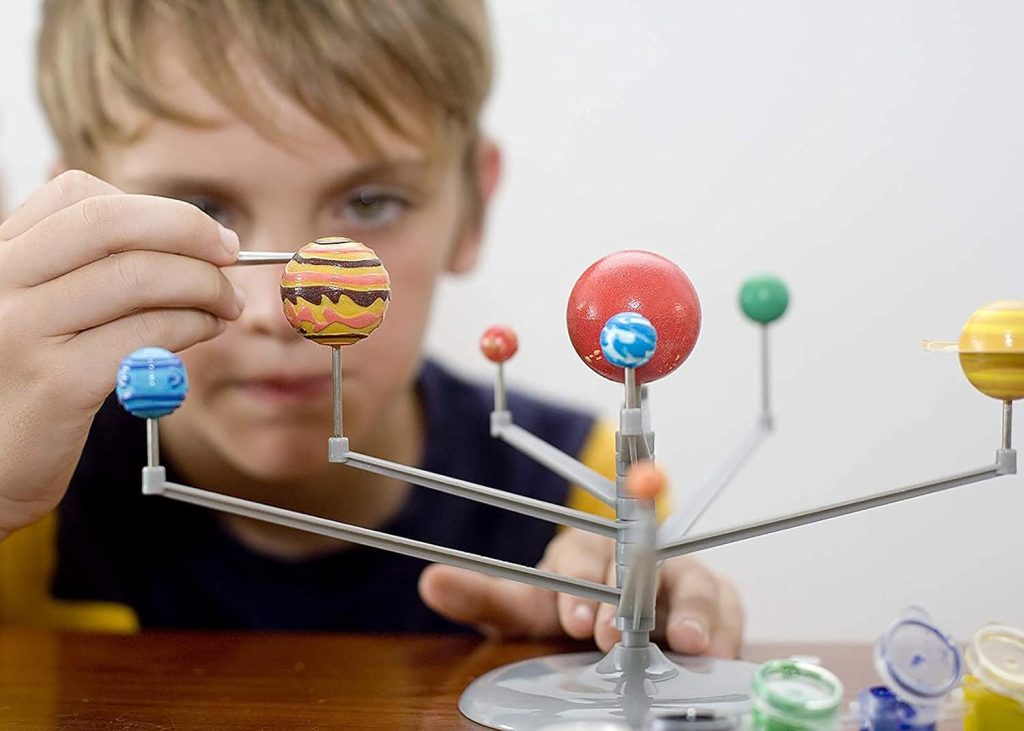
Creating Your Cosmic Masterpiece: Assembly Insights
Setting Up for Success
Smart preparation prevents frustration and ensures enjoyable creation:
Workspace Considerations: Choose a well-lit area where paint spills won’t cause household disasters. Kitchen tables work well when protected with newspaper or plastic sheeting. Adequate space prevents cramped working conditions that lead to accidents.
Time Allocation: Don’t attempt this as a quick pre-dinner activity. Quality results require several hours spread across multiple sessions. Paint needs proper drying time between layers—rushing guarantees disappointment.
Gather Extras: While the kit includes essentials, consider supplementing with additional acrylic paints for more color variety, finer brushes for detailed work, and reference images showing actual planetary appearances.
Mindset Preparation: Frame this as a journey rather than a race. The process matters as much as the finished product. Mistakes become learning opportunities rather than failures.
The Construction Journey
Phase One: Planet Assembly Most planets arrive in hemisphere halves requiring connection. This seemingly simple step teaches children about three-dimensional geometry. How do curved surfaces align? What happens if you force pieces incorrectly? Gentle persistence pays off.
Phase Two: Artistic Expression Here, science meets creativity. While encouraging accuracy (Jupiter’s bands, Mars’s rusty color), allow artistic interpretation. Perhaps your child imagines Saturn’s rings with unexpected colors or adds imaginative details inspired by science fiction. This balance between fact and creativity makes the project personally meaningful.
Phase Three: Glow Application The luminescent paint requires strategic thinking. Which surfaces will be most visible in darkness? How thickly should it be applied? Experimentation reveals that thin, even coats produce better glow effects than thick globs.
Phase Four: Drying Patience This might be the hardest part—waiting. Use this time productively by reading planetary facts from the wall chart or discussing what children are learning. This transforms waiting from boredom into continued education.
Phase Five: Structural Assembly Threading string through attachment points and balancing the mobile tests spatial reasoning and problem-solving. If planets cluster on one side, how do you redistribute weight? This practical physics lesson feels like puzzle-solving rather than schoolwork.
Phase Six: Installation Choosing the display location matters. High-traffic areas keep the project visible and relevant. Near a bed allows nighttime observation of the glow effect. Consider both practical concerns (ceiling hook placement, distance from walls) and educational goals (visibility, accessibility for reference).
Maximizing the Glow Effect
Since the luminescence captivates children, optimise it:
Charging Process: Expose the painted planets to bright light for at least thirty minutes before expecting glow effects. Natural sunlight works best, though artificial light suffices.
Realistic Expectations: The glow lasts fifteen to thirty minutes, not all night. This provides perfect bedtime viewing but won’t illuminate the room hours later.
Recharging: The glow effect isn’t one-time-use. Daily light exposure maintains the nighttime magic indefinitely.
Enhancement Ideas: Shining a flashlight directly on planets before turning off lights intensifies the initial glow, creating a more dramatic effect for special occasions.
Extending the Learning: Activities Beyond Assembly
The planetarium’s educational value extends far beyond the building process:
Comparative Exploration
Use your completed model for hands-on investigations:
Size Studies: How many Earth-sized marbles would fit inside Jupiter? Visual comparison using the models makes this concrete rather than abstract.
Distance Demonstrations: While your model can’t show true scale distances (Neptune would be blocks away!), use it to discuss why space travel takes so long and why we can’t easily visit other planets.
Composition Contrasts: Why are inner planets rocky while outer planets are gaseous? The model provides visual reference for these discussions.
Creative Integration
Astronomy inspires storytelling and artistic expression:
Narrative Writing: “Imagine you’re an explorer visiting each planet. Describe what you see, feel, and discover.” This assignment combines science facts with creative writing skills.
Poetry Projects: Planetary poems can explore scientific facts through artistic language. “Mercury, scorched sentinel, racing round the Sun…”
Art Expansion: Draw what alien life might look like if it evolved on Jupiter’s clouds or beneath Europa’s ice. Science-based speculation exercises both creativity and scientific thinking.
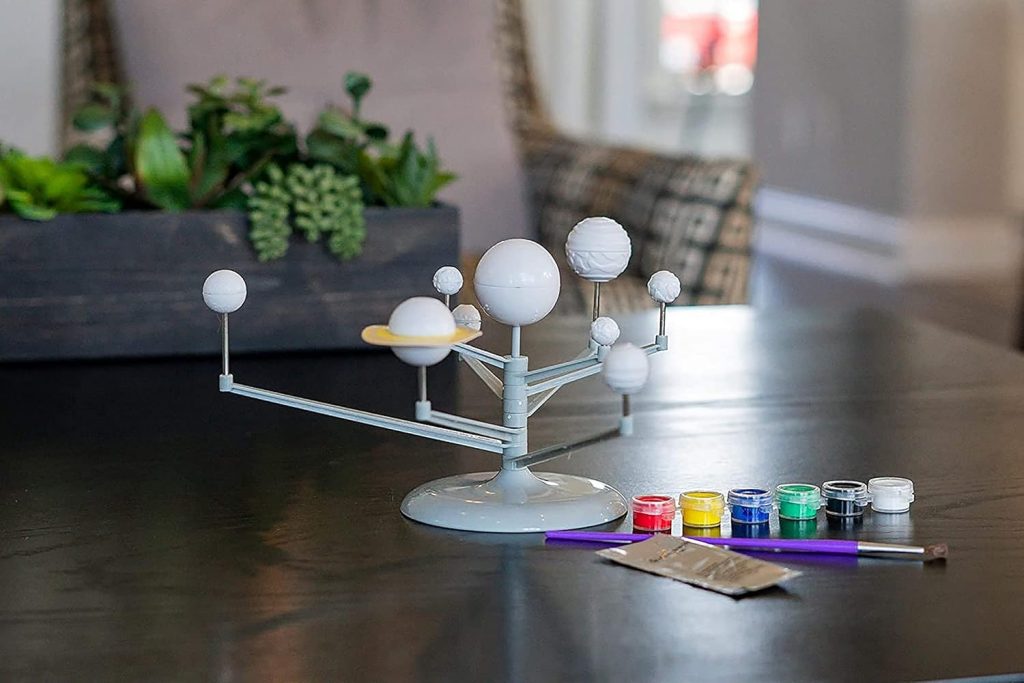
Mathematical Applications
Your model becomes a math manipulative:
Ratio Calculations: If Earth represents one unit, how many units tall is Jupiter? Practice proportional reasoning using the physical models.
Orbital Period Problems: “If Mercury orbits in 88 days and Earth in 365, how many Mercury years equal one Earth year?” The model makes these calculations meaningful.
Gravity Explorations: Calculate weight differences on various planets. A 100-pound person weighs only 38 pounds on Mercury but 236 pounds on Jupiter. Why? The model provides context for these discussions.
Real-World Connections
Bridge your indoor model with outdoor reality:
Planet Spotting: Download astronomy apps showing which planets are currently visible. Finding Venus in the evening sky or Jupiter near the moon connects your model with actual celestial bodies.
Space Mission Tracking: When NASA missions explore Mars or orbit Jupiter, follow their progress and locate those planets on your model, making distant missions feel more immediate and relevant.
Seasonal Changes: Observe how Earth’s tilt (demonstrated with your model) creates seasons, then notice seasonal changes outside your window. Abstract concepts become lived experiences.
Understanding 4M: The Company Behind the Cosmos
Educational Philosophy in Action
4M Industrial Development Limited has built its reputation on a simple but powerful premise: learning should be active, engaging, and fun. Their extensive catalog—spanning science experiments, artistic projects, and robotic building—consistently reflects this philosophy.
The company’s approach recognizes that children learn best when they’re genuinely engaged rather than forced through rote memorization. By creating products that children want to interact with, 4M makes education feel like play rather than work.
Quality You Can Trust
Safety and durability aren’t marketing buzzwords for 4M—they’re foundational principles:
Material Safety: All paints and plastics meet strict safety standards. Parents can feel confident that components are non-toxic and child-safe.
Durability Design: Unlike flimsy toys that break immediately, 4M products are engineered for longevity. Your completed planetarium withstands years of display without deterioration.
Clear Communication: Instructions use straightforward language and clear diagrams, respecting children’s intelligence while ensuring comprehension.
The Broader 4M Ecosystem
While the Solar System Planetarium stands alone as a complete experience, 4M offers complementary products that extend learning:
Related Science Kits: Crystal growing, volcano building, and weather station construction explore other scientific domains using similar hands-on approaches.
Engineering Projects: From robotic arms to renewable energy demonstrations, 4M’s engineering kits build on skills developed through planetarium construction.
Environmental Education: Products focusing on sustainability and ecology align with the planetarium’s battery-free, low-waste design philosophy.
Investment Analysis: Is This Kit Worth Your Money?
Breaking Down the Value Proposition
At roughly $15-$25, the 4M Solar System Planetarium competes with movie tickets, video games, and fast food outings. How does it compare?
Immediate Entertainment Value: Construction provides several focused hours of engagement—matching or exceeding a movie’s entertainment duration but with creative participation rather than passive viewing.
Educational Return: Knowledge gained persists far beyond the assembly process. The displayed model serves as a daily reminder and reference tool, reinforcing learning through repeated exposure.
Reusability Factor: Unlike consumable entertainment (movies, restaurant meals), the planetarium remains functional indefinitely. Younger siblings benefit from the same kit, multiplying its value.
Skill Development: Fine motor improvement, spatial reasoning growth, and increased scientific literacy represent investments in your child’s capabilities that compound over time.
Cost Comparison Context
Versus Science Museums: A family visit to a science museum might cost $50-100 for tickets alone. While museums offer broader experiences, the planetarium provides deeper engagement with its specific subject.
Versus Tutoring: A single hour of professional tutoring costs $30-75 in most markets. The planetarium delivers multiple hours of educational engagement at a fraction of that cost.
Versus Books: Individual books cost $10-20 and provide excellent information. However, the planetarium’s hands-on nature reaches learners who struggle with text-based learning.
Versus Digital Subscriptions: Educational app subscriptions run $5-15 monthly. The planetarium’s one-time purchase provides ongoing value without recurring fees or screen time concerns.
Hidden Value Considerations
Family Bonding: Collaborative assembly creates shared memories and conversation topics that strengthen family connections—priceless outcomes that transcend monetary value.
Confidence Building: Successfully completing a challenging project boosts self-esteem in ways that purchased accomplishments cannot match.
Interest Ignition: For some children, this kit sparks lifelong passion for astronomy, potentially influencing career choices and lifelong hobbies—an immeasurable return on investment.
Smart Shopping: Where and How to Buy
Retail Options
Online Marketplaces: Amazon typically stocks the kit with customer reviews providing real-world feedback. Prime shipping offers convenience for last-minute gift needs.
Educational Specialty Retailers: Companies focusing on learning toys often provide better customer service and educational guidance than general retailers.
Museum Gift Shops: Planetariums and science museums frequently carry the kit, supporting educational institutions through your purchase.
Direct from 4M: Purchasing through the manufacturer’s website occasionally provides bundle deals or exclusive offers.
Purchasing Strategy
Price Monitoring: Bookmark the product at multiple retailers and watch for sales. Back-to-school periods and holiday seasons often bring discounts.
Bundle Opportunities: Some retailers offer package deals combining the planetarium with related products (space books, star charts, etc.) at reduced total cost.
Authenticity Verification: Ensure you’re purchasing genuine 4M product (Model 3427) rather than knockoffs. Authentic products guarantee the quality and safety standards described here.
Shipping Considerations: While the kit isn’t fragile, faster shipping reduces the wait for excited children. Factor shipping costs into your total investment calculation.
Gift Presentation Ideas
Enhanced Packaging: Consider pairing the kit with astronomy books, a flashlight for nighttime planet viewing, or star chart for outdoor observation.
Experience Addition: Include planetarium tickets or an online telescope tour to complement the hands-on kit with professional astronomy experiences.
Personalization: Add a custom note explaining why you chose this gift, perhaps sharing your own memories of learning about space.
Real Families, Real Experiences: What Parents Report
The Enthusiasm Factor
Parents consistently highlight how the kit captures and maintains attention far longer than typical toys. One mother shared, “My son spent an entire Saturday afternoon painting planets, something I’d never seen him do with any other activity.”
The glow feature receives particular praise. Bedtime resistance often dissolves when children know their glowing planets await them. This nightly ritual keeps astronomy relevant days, weeks, even months after assembly completion.
Educational Wins
Teachers report using the kit as the centerpiece for astronomy units, with students showing measurably better comprehension when learning accompanies hands-on planetarium construction. Abstract concepts crystallize into concrete understanding.
Homeschooling families appreciate how one kit satisfies multiple subject requirements—science content, art standards, reading comprehension through the fact chart, and even physical education if you count hanging the finished mobile!
Navigating Challenges
Honest feedback reveals occasional frustrations. Some eight-year-olds need more adult assistance than packaging suggests, particularly with fine motor tasks like precise painting or string threading.
The glow duration sometimes disappoints children expecting all-night illumination. Setting realistic expectations beforehand prevents this disappointment: “It’ll glow like a night light for about twenty minutes after we turn off the lights.”
Paint messiness catches some families off-guard. Veteran parents recommend old clothes, covered surfaces, and acceptance that some paint will migrate to unexpected places—consider it evidence of engaged learning!
Transformational Stories
Beyond typical satisfaction, some families report profound impacts. One parent described how the kit helped their reluctant learner discover a passion for science, ultimately improving school performance across subjects.
Another family used collaborative assembly as therapy during difficult times, finding that working together toward a shared goal strengthened relationships while creating a lasting symbol of what they could accomplish together.
Making the Most of Your Investment: Pro Tips
Before Assembly
Build Anticipation: Don’t immediately dive into construction. Spend time discussing what you’ll create, watching astronomy videos together, or visiting a planetarium first. This context enriches the subsequent building experience.
Establish Expectations: Discuss that mistakes happen, paint takes time to dry, and the best results require patience. Frame challenges as learning opportunities.
Document the Journey: Plan to photograph or video key moments. These records become treasured memories and allow children to see their own skill development.
During Construction
Resist Taking Over: When children struggle, support rather than rescue. “What do you think might work?” encourages problem-solving better than “Here, let me do it.”
Embrace Imperfection: Slightly wobbly Saturn rings or unevenly applied paint represent authentic effort. Perfectionism can drain joy from creative projects.
Use Waiting Time Wisely: While paint dries, read astronomy facts aloud, quiz each other, or watch space documentaries. Transform downtime into continued learning.
After Completion
Ritual Creation: Establish routines incorporating the planetarium. Perhaps bedtime includes five minutes of stargazing at the glowing planets, or weekly quiz sessions test retention.
Knowledge Updates: When space news breaks—a new Mars discovery, asteroid flyby, or exoplanet identification—discuss how it relates to the displayed planets.
Expansion Opportunities: As children master basic planetary facts, introduce more complex concepts like elliptical orbits, gravitational influences, or comparative planetology.
Maintenance Matters: Dust accumulation dulls the glow effect and appearance. Monthly gentle cleaning with a soft cloth maintains visual appeal and glow intensity.
Frequently Asked Questions: Expert Answers
Q: Will younger children enjoy this kit? While 8+ is recommended, supervised six or seven-year-olds can participate with appropriate adult support. Focus on their contribution (painting, choosing colors) while handling complex assembly yourself.
Q: How long does assembly take? Plan for 3-4 hours total, ideally split across multiple sessions to allow proper paint drying. Rushing compromises results and enjoyment.
Q: Can multiple children work on one kit? Absolutely! Assign different planets to each child, or divide tasks—one assembles while another paints. Collaboration often enhances the experience.
Q: What happens if we lose the glow paint pen? Glow-in-the-dark paint is available at craft stores. While not identical to the included pen, alternative products work similarly. Some families enhance with additional glow colors for creative effects.
Q: Is scientific accuracy maintained? Relative planet sizes are accurate. However, displaying distances to scale is impossible (Neptune would be blocks away!). Use this limitation to discuss scale challenges in representing space.
Q: How do I hang the mobile safely? Ceiling hooks (available at hardware stores) rated for appropriate weight work well. Position away from ceiling fans and where accidental contact won’t damage the display.
Q: Will the glow fade over time? Glow properties remain functional indefinitely with regular light exposure. Planets won’t spontaneously lose glow capability.
Q: Can this work in classrooms? Excellently! Consider having student groups each complete one planet, then assembling a class-wide solar system. This collaborative approach engages entire classrooms.
The Bigger Picture: Why Hands-On Science Matters
Screen Time Balance
With children spending unprecedented hours on devices, finding engaging screen-free alternatives matters more than ever. The 4M Solar System Planetarium offers genuine absorption without digital devices—no easy achievement in our connected world.
Research increasingly links excessive screen time with attention difficulties, sleep disruption, and reduced physical activity. This kit provides intellectually stimulating engagement while giving eyes and brains screen-free restoration time.
Combating Science Illiteracy
National science literacy rates concern educators and policymakers. When fundamental concepts like planetary order or basic astronomical facts elude adults, we’ve failed our educational mission.
Early positive science experiences create foundation for lifelong learning. Children who enjoy science exploration continue seeking scientific knowledge throughout life. This kit plants those crucial seeds.
Building Tomorrow’s Problem-Solvers
Our world faces complex challenges requiring scientific thinking—climate change, resource management, technological advancement. Today’s children will inherit and must solve these problems.
Skills developed through kit assembly—critical thinking, problem-solving, persistence through challenges—directly prepare children for future demands. We’re not just teaching astronomy; we’re building capable, resilient thinkers.
Final Verdict: Should You Buy the 4M Solar System Planetarium?
After exhaustive examination, the verdict is clear: this kit delivers exceptional value for families and educators seeking meaningful, engaging education.
Strong Yes If:
- Your child shows any interest in space, science, or hands-on projects
- You value screen-free activities that genuinely engage children
- You want gifts with lasting impact beyond initial excitement
- You’re building homeschool curriculum needing tangible components
- You seek classroom projects that excite while educating
Consider Carefully If:
- Your child is significantly younger than eight with limited fine motor skills
- You have very limited space for displaying hanging projects
- You want instant gratification without assembly time investment
- You prefer ready-made displays requiring zero effort
The Bottom Line
For under $25, you’re not just buying a toy—you’re purchasing hours of quality engagement, lasting scientific knowledge, skill development across multiple domains, and quite possibly, the spark that ignites lifelong passion for astronomy and science.
The 4M Solar System Planetarium transforms abstract space concepts into tangible, personal understanding. When your child looks upward at their glowing creation each night, they’re not just seeing planets—they’re seeing evidence of their own capability, creativity, and connection to the magnificent cosmos surrounding our tiny blue marble.
In an age of disposable entertainment and instant gratification, this kit stands as a reminder that the best learning experiences require time, effort, and personal investment. The reward isn’t just a completed project—it’s a confident, knowledgeable young person who understands that with patience and persistence, they can create something truly wonderful.
Give your child the universe. They’ll give you back their limitless potential.

